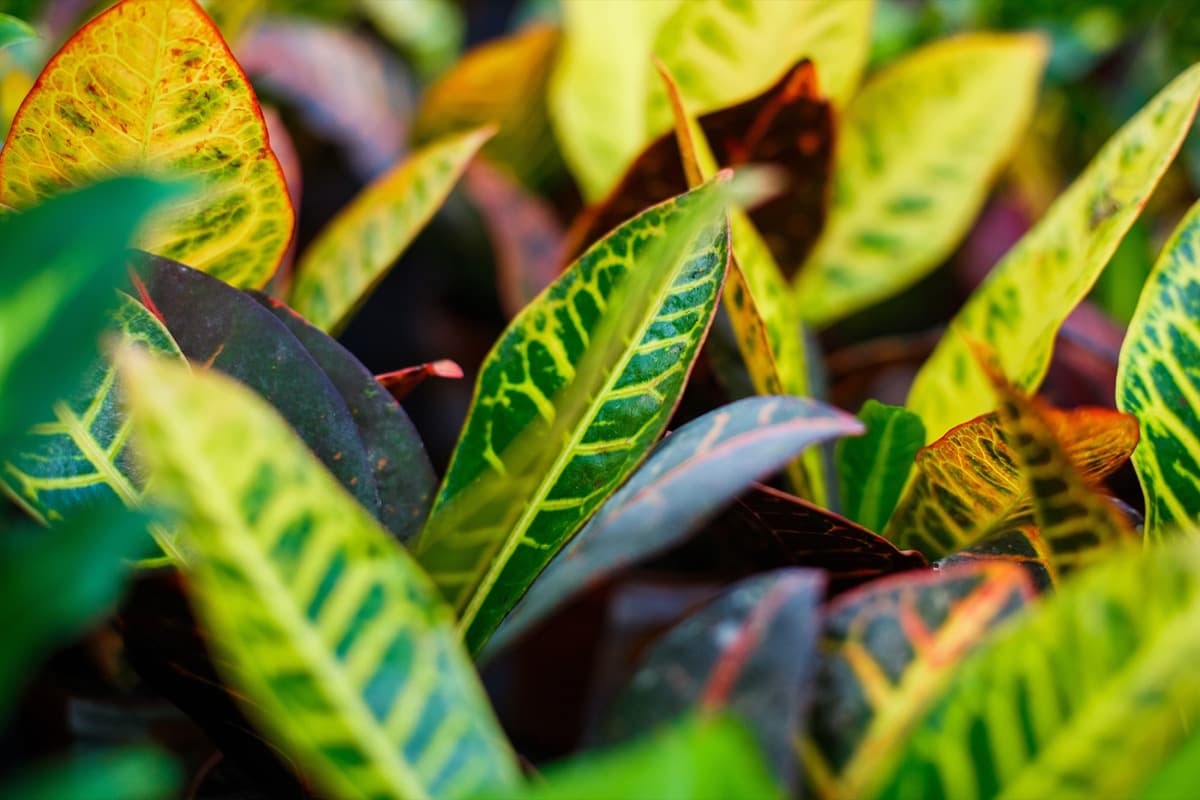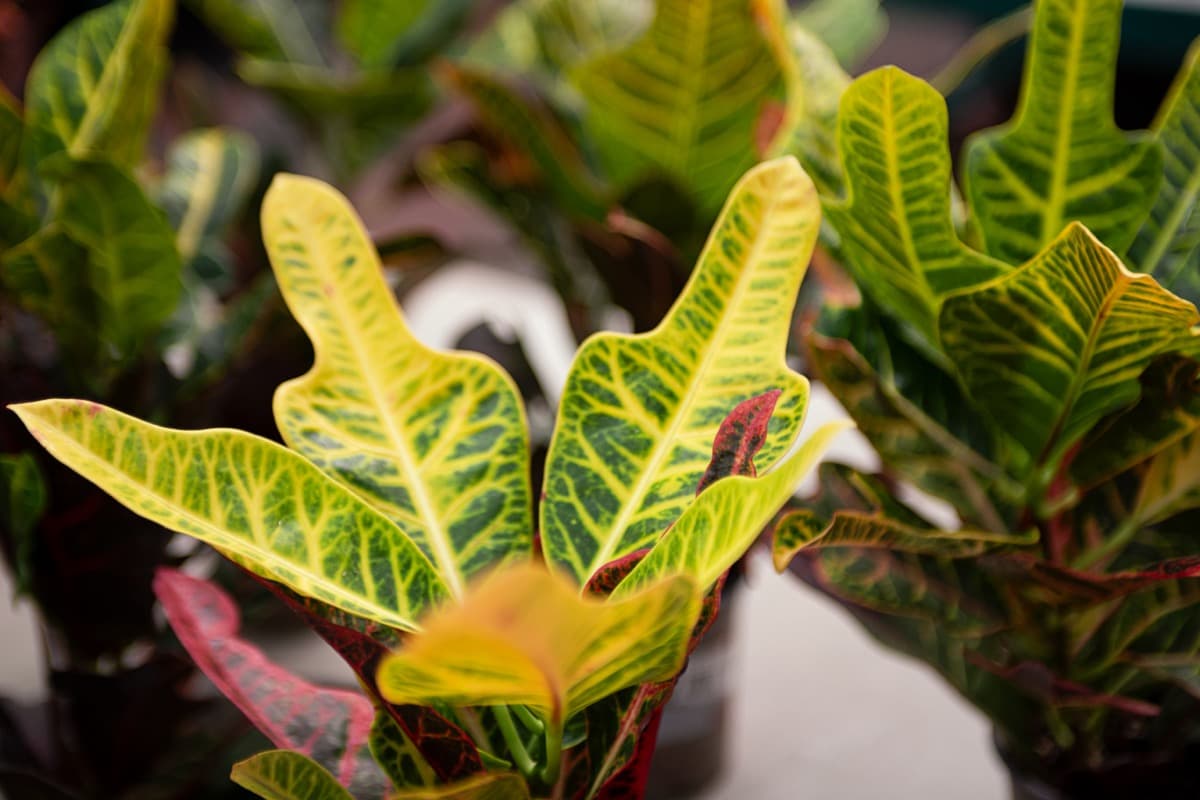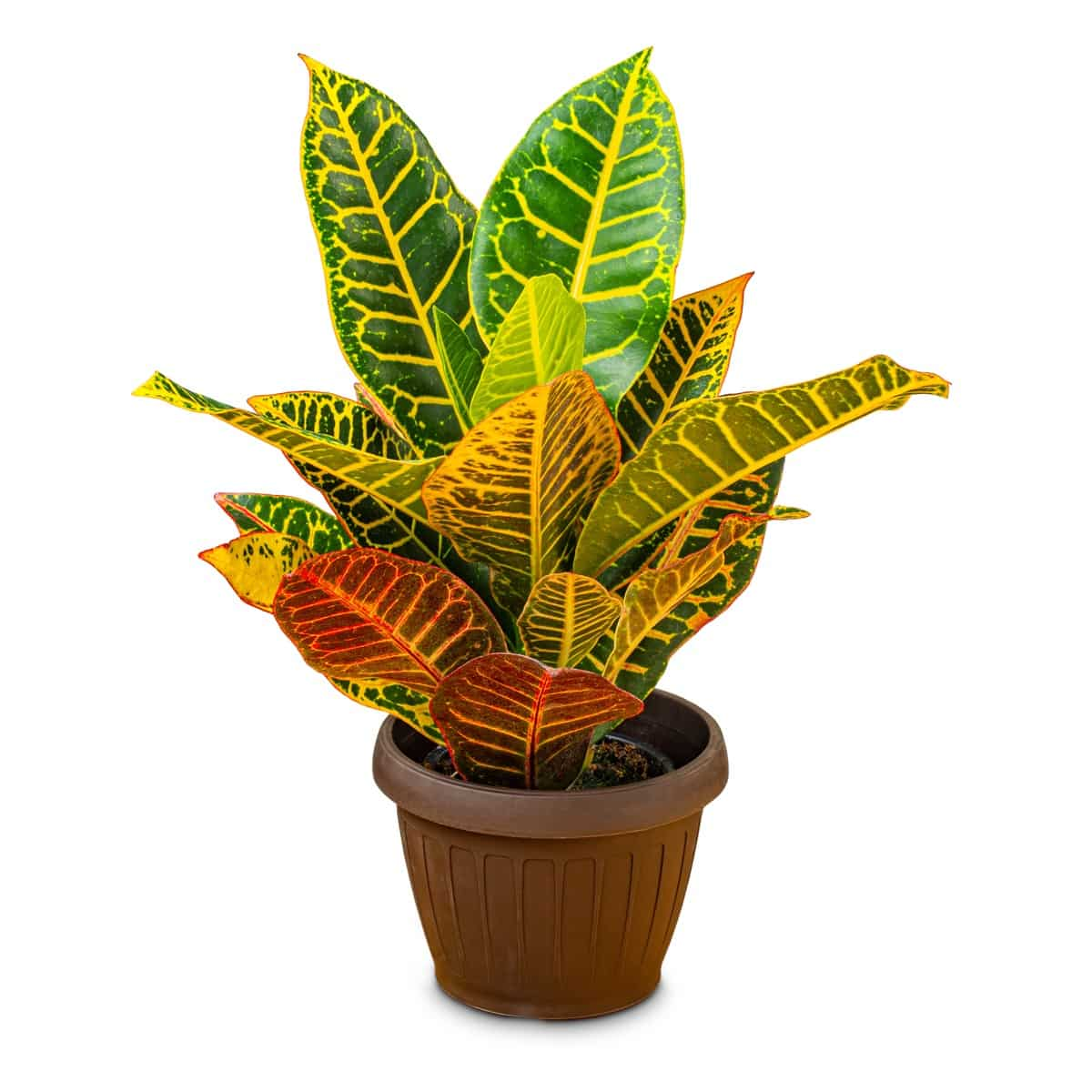Welcome to our blog on common Croton plant pests and control! This article will explore the causal organisms, damage symptoms, spread, treatment options, prevention strategies, and management techniques for these pests. Join our team in exploring different strategies to protect your Croton plants and ensure good yields. Now it’s time to begin.

Major and Common Damaging Croton Pests
Croton is a perennial flowering evergreen plant in the Euphorbiaceae family, native to tropical regions worldwide. It encompasses diverse flowering plants known for their vibrant foliage, striking colors, unique leaf shapes, and ornamental appeal. With over 1,000 known species, Croton plants exhibit various scientific characteristics, including growth habits, leaf patterns, and sizes.
They are popular indoor and outdoor landscaping choices, adding a touch of tropical beauty to gardens, landscapes, and interior spaces, providing a lively and dramatic atmosphere wherever they are cultivated.
| Pest | Characteristic Symptoms |
| Aphids | Honeydew, sooty mold, leaf yellowing, & reduced plant vigor. |
| Thrips | Silvering, bronzing, frass, & leaf and flower scarring. |
| Red Spider Mites | Webbing, stippling, bronzing or mottling, & premature leaf drop. |
| Mealybugs | White, cottony masses or waxy secretions, honeydew, & sooty mold. |
| Brown Scale Insects | Oval-shaped insects, dieback, yellowing, & wilting. |
| Leaf Miners | Serpentine mines, blotchy patches, & premature leaf drop. |
| Caterpillars | Leaf skeletonization, ragged leaf edges, & frass droppings. |
| Slugs | Silvery slime trails & shredding of leaves. |
| Snails | Extensive chewing damage & irregular holes. |
| Whiteflies | Leaf yellowing & wilting, honeydew, sooty mold, & reduced flowering. |
How to Identify and Treat Croton Pests
Aphids Pest Control in Croton
- Causal Organism: Aphis gossypii and Myzus persicae.
- Symptoms: The characteristic symptom is a sticky honeydew residue on leaves, attracting ants, resulting from feeding damage due to the sucking of plant sap. Infested plants show leaf curling, distortion, yellowing, stunted growth, sooty mold, and reduced plant vigor.
- Favorable Conditions: They prefer warm and moderately humid conditions of 30-35 °C, tender growth, succulent plant tissues, overcrowding, and weak plants for feeding, reproduction, and survival.
- Treatment: Spray potassium salts of fatty acids, neem oil, imidacloprid, or acetamiprid. Remove heavily infested plant parts and dispose of them properly. Use a strong stream of water to dislodge aphids from the plant. Release predators like ladybugs and lacewings.
Thrips Pest Control in Croton
- Causal Organism: Frankliniella occidentalis and Thrips palmi.
- Symptoms: The visible symptom is the presence of tiny, slender insects on leaves and flowers. Infested plants show leaf distortion, curling, silvering, frass, leaf and flower scarring, and bronzing.
- Favorable Conditions: They prefer warm, arid, and mildly humid weather conditions of 28-35 °C, flowering or reproductive plant stages, pollen and nectar sources, tender growth, areas with less rainfall, and overcrowded plantations for reproduction.
- Treatment: Spray insecticidal soaps, pyrethroids, neem oil, spinosad, acetamiprid, or imidacloprid. Remove heavily infested plant parts and dispose of them. Use blue or yellow sticky traps to monitor and catch adult thrips. Release natural enemies like minute pirate bugs or predatory mites.
Red Spider Mite Pest Control in Croton
- Causal Organism: Tetranychus urticae and Tetranychus cinnabarinus.
- Symptoms: The visible symptom is the fine webbing on leaves and stems. Infested plants show leaf yellowing, stippling, bronzing or mottling, distortion, curling, premature leaf drop, and reduced plant vitality.
- Favorable Conditions: They prefer hot and dry environments of 29-36 °C and < 50% humidity, dusty or dirty foliage, high-density plantations, drought areas, poor air circulation, and infested plant debris.
- Treatment: Spray insecticidal soaps, neem oil, abamectin, fenazaquin, etoxazole, and spiromesifen. Remove and destroy heavily infested leaves. Increase humidity by misting the leaves regularly. Use natural predators like predatory mites.
In case you missed it: How to Identify and Treat Nerium Diseases: Damage Symptoms, Prevention, and Control

Mealybug Pest Control in Croton
- Causal Organism: Planococcus lilacinus and Pseudococcus longispinus.
- Symptoms: The primary symptom is the white, cottony masses or waxy secretions on leaves, stems, and axils. Infested plants show leaf yellowing, wilting, honeydew, sooty mold, reduced plant vigor, and distorted growth of affected plant parts.
- Favorable Conditions: They prefer moderate temperatures and humid conditions of 23-27 °C and > 70% humidity, tender growth, crowded or compacted plantings, and plant parts with crevices or protected areas.
- Treatment: Spray potassium salts of fatty acids, neem oil, imidacloprid, acetamiprid, or thiamethoxam. Use a cotton plug dipped in isopropyl alcohol to remove the pests manually. Prune and destroy heavily infested plant parts. Use Cryptolaemus montrouzieri or ladybugs.
Brown Scale Insect Pest Control in Croton
- Causal Organism: Saissetia coffeae, Pseudaulacaspis pentagona, and Coccus hesperidum.
- Symptoms: The characteristic symptom is the presence of small, immobile, and round or oval-shaped insects on leaves and stems. Infested plants show leaf yellowing, wilting, distortion, honeydew secretion, sooty mold growth, stunted growth, and dieback.
- Favorable Conditions: They prefer mildly warm and very humid conditions of 20-27 °C and > 70% humidity, sheltered areas or plant parts with nooks and crannies, vegetative growth, overcrowding, areas that lack airflow, and natural predators for reproduction and survival.
- Treatment and Management: Spray potassium salts of fatty acids, neem oil, imidacloprid, or dinotefuran. Prune and dispose of heavily infested plant parts, and use cotton dipped in isopropyl alcohol and predatory beetles or parasitic wasps.
Croton Leaf Miner Pest Control in Croton
- Causal Organism: Liriomyza trifolii and Liriomyza huidobrensis.
- Symptoms: The characteristic symptom is the presence of meandering, winding, or serpentine mines on leaves. Infested leaves show blotchy or discolored patches, curling, distortion, reduced plant vigor, premature leaf drop, and stunted growth.
- Favorable Conditions: They prefer moderate temperatures and humidity of 23-27 °C and 50-60% humidity, healthy and succulent leaves, and areas that lack natural predators for egg-laying and larval development.
- Treatment and Management: Spray imidacloprid, abamectin, spinosad-based insecticides, or thiamethoxam. Remove and destroy heavily infested leaves. Keep the growing area free of weed hosts that can serve as alternate hosts. Release natural enemies like parasitic wasps.
Croton Caterpillar Pest Control in Croton
- Causal Organism: Achaea janata, Spodoptera litura, and Trichoplusia ni.
- Symptoms: The most prominent symptom is the caterpillar chewing damage on leaves, resulting in a characteristic pattern of skeletonization and irregular holes or notches. Infested plants show ragged leaf edges, extensive defoliation, and frass droppings.
- Favorable Conditions: They prefer warm environments of 27-35 °C, abundant food sources, suitable host plants, dense vegetation, and areas that lack natural predators with minimal disturbance.
- Treatment and Management: Spray Bacillus thuringiensis var. kurstaki, pyrethroids, carbaryl, or spinosad. Handpick and remove caterpillars from plants. Use physical barriers like netting to protect plants from adult egg-laying. Release natural enemies like birds or beneficial wasps.
Slugs Pest Control in Croton
- Causal Organism: Deroceras reticulatum.
- Symptoms: The characteristic symptom is the presence of silvery slime trails on foliage and surrounding areas. Damage typically occurs at night or during periods of high humidity. Infested plants show irregular holes or shredding of leaves.
- Favorable Conditions: They prefer cool and moist conditions of 15-23 °C and > 80% humidity, shaded areas with high humidity, organic matter or mulch, and less or no natural predators for hiding and breeding.
- Treatment and Management: Use slug baits containing metaldehyde or iron phosphate. Handpick slugs during evening hours when they are active. Remove debris, mulch, or hiding places. Create barriers like copper tape or diatomaceous earth around vulnerable plants.
Snails Pest Control in Croton
- Causal Organism: Helix aspersa and Otala lactea.
- Symptoms: The characteristic symptom is the presence of silvery slime trails on foliage and surrounding areas. Damage typically occurs at night or during periods of high humidity. Infested plants show irregular holes or shredding of leaves, similar to slug damage.
- Favorable Conditions: They prefer cool and moist conditions of 15-20 °C and > 70% humidity, shaded areas with high humidity, organic matter or mulch, stressed or wounded plants, and crowded plantations for hiding and breeding.
- Treatment and Management: Use snail baits containing metaldehyde or iron phosphate. Handpick snails during highly active evening hours. Remove debris, mulch, or hiding shelters. Use barriers like copper tape or diatomaceous earth around vulnerable plants.
In case you missed it: Management of Crown Mite in Spinach: Symptoms, Treatment, Chemical, Biological, Natural, and Organic Control

Croton Whitefly Pest Control in Croton
- Causal Organism: Bemisia tabaci and Trialeurodes vaporariorum.
- Symptoms: The characteristic symptom is the presence of small white insects flying around the plant when disturbed and yellowing and wilting of leaves due to feeding damage. Infested plants show leaf curling, distortion, honeydew secretion, sooty mold, and reduced flowering.
- Favorable Conditions: They prefer warm and very moist weather of 27-35 °C and >80% humidity, the presence of lush, new growth, weeds, protection from extreme weather conditions, overcrowding, and poor airflow for development and reproduction.
- Treatment and Management: Spray potassium salts of fatty acids, neem oil, imidacloprid, or acetamiprid. Prune and remove heavily infested plant parts. Use yellow sticky traps to monitor and catch adult whiteflies. Release Encarsia formosa or Delphastus spp.
Conclusion
Some major pests affecting croton plants include aphids, thrips, red spider mites, mealybugs, brown-scale insects, leaf miners, caterpillars, slugs, snails, and whitefly pests. Various organisms cause these pests and exhibit specific symptoms, modes of spread, and management approaches.
- Deworming Schedule for Dogs/Puppies: A Beginners Guide
- How to Prevent and Control Parasites in Goats
- Beneficial Insects in Pest Management
- Natural Solutions for Pest Control in Flower Gardens
- Types of Fungicides Used in Agriculture
- Common Issues in the Fruit Development Stage of Pomegranate Farming
- Fruit Development Issues in Papaya: Easy Solutions and Treatment
- Soil-Borne Diseases and How to Protect Your Plants
- Practices to Prevent Disease Spread in the Garden